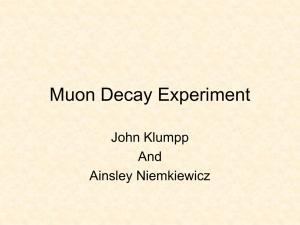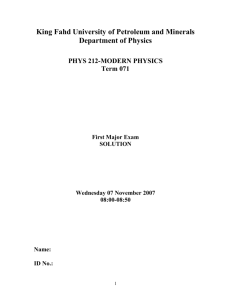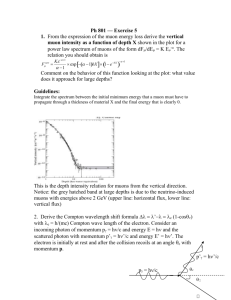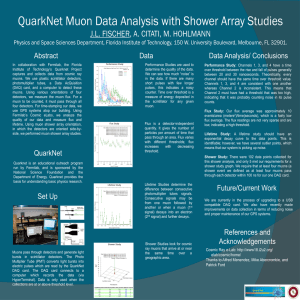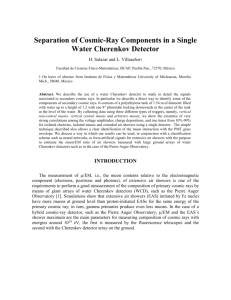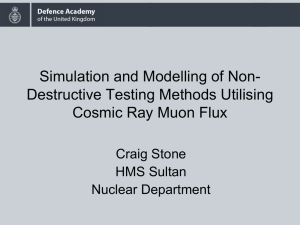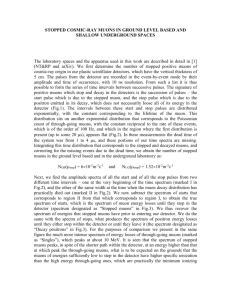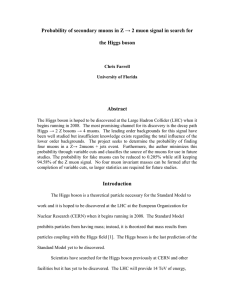The Muon Decay Experiment - a simulation
advertisement
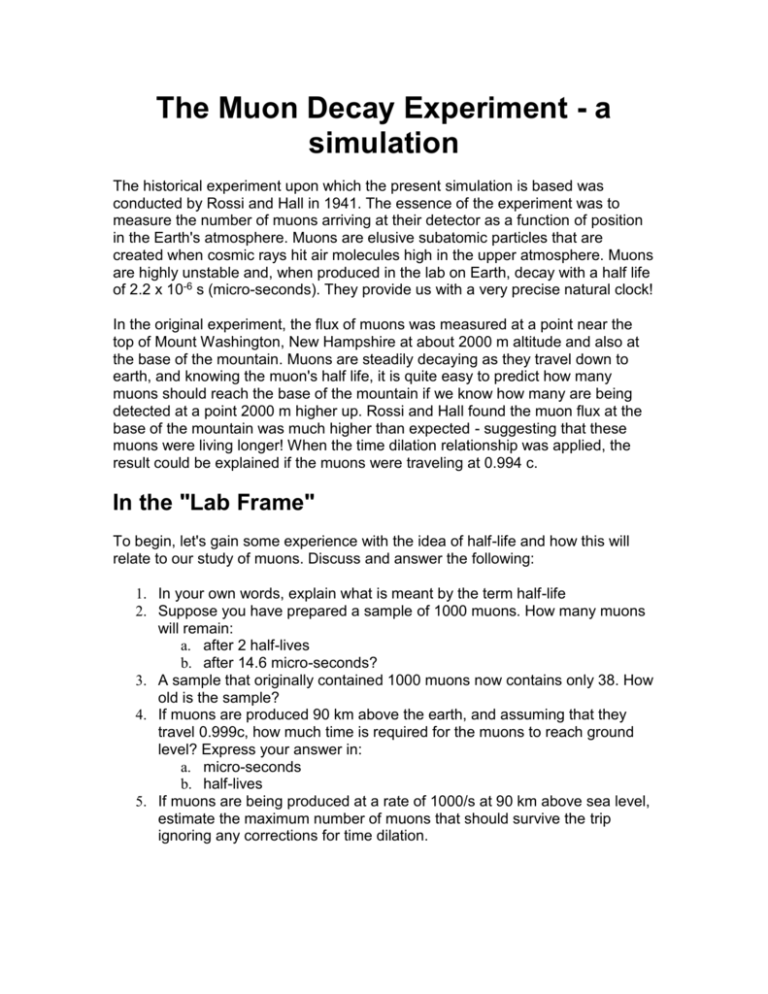
The Muon Decay Experiment - a simulation The historical experiment upon which the present simulation is based was conducted by Rossi and Hall in 1941. The essence of the experiment was to measure the number of muons arriving at their detector as a function of position in the Earth's atmosphere. Muons are elusive subatomic particles that are created when cosmic rays hit air molecules high in the upper atmosphere. Muons are highly unstable and, when produced in the lab on Earth, decay with a half life of 2.2 x 10-6 s (micro-seconds). They provide us with a very precise natural clock! In the original experiment, the flux of muons was measured at a point near the top of Mount Washington, New Hampshire at about 2000 m altitude and also at the base of the mountain. Muons are steadily decaying as they travel down to earth, and knowing the muon's half life, it is quite easy to predict how many muons should reach the base of the mountain if we know how many are being detected at a point 2000 m higher up. Rossi and Hall found the muon flux at the base of the mountain was much higher than expected - suggesting that these muons were living longer! When the time dilation relationship was applied, the result could be explained if the muons were traveling at 0.994 c. In the "Lab Frame" To begin, let's gain some experience with the idea of half-life and how this will relate to our study of muons. Discuss and answer the following: 1. In your own words, explain what is meant by the term half-life 2. Suppose you have prepared a sample of 1000 muons. How many muons will remain: a. after 2 half-lives b. after 14.6 micro-seconds? 3. A sample that originally contained 1000 muons now contains only 38. How old is the sample? 4. If muons are produced 90 km above the earth, and assuming that they travel 0.999c, how much time is required for the muons to reach ground level? Express your answer in: a. micro-seconds b. half-lives 5. If muons are being produced at a rate of 1000/s at 90 km above sea level, estimate the maximum number of muons that should survive the trip ignoring any corrections for time dilation. 6. Derive the following formula: where is the half-life, No is the original number of muons in the sample and N(t) is the number of muons after time t. (Hint: ) 7. The following table provides decay information for a sample of muons. Plot this data in EXCEL and fit an exponential trendline and from this determine the half-life for the muon. t (mu s) 0 1 2 3 4 5 6 7 8 9 10 11 N(t) 1010.00 742.56 559.38 422.77 301.33 218.83 160.38 136.86 84.45 75.33 59.36 31.99 The Simulation 1. Our simulation allows us measure the muon flux by moving a probe to various heights in the atmosphere. Do this by clicking on the probe and dragging. (Press help on the applet for more information.) 2. To make a reading press the start button ( found bottom left) and then press the stop button ( ). 3. The muon flux will be measured and recorded for you. 4. Start at an altitude of 150 km and make measureme nts in 10 km steps (finer if you wish) as you move down to ground level. 5. When you have collected your data press the graph button ( ) then right-mouse click in the graph panel and choose the generate table option to export your data into EXCEL. image only - click here to load the applet on a separate page Procedure and Analysis 1. You will need to re-arrange your data to enable you to put it into a table similar to the one given in question 7 above. To do this you will need to estimate the time taken for the muons to travel from 90 kms to the heights at which you measured the muon flux. Since we expect that the muons are moving at nearly the speed of light we can estimate this time by simply adopting "c" as the velocity of the muons. Prepare a table that looks like: Distance Travelled (from 90 km) 0 10 Time (micro seconds) ----- Muon Flux ----- 2. Plot a curve and trendline for your data and from this determine the halflife of the muons that you measured with the probe. 3. You should get a very different half-life for the moving muons than for the lab frame muons (2.2 micro-seconds). Compare the two half-lives; which is "longer" and by what factor? Questions 1. Explain how your data illustrates the equation where 2. What value for gamma does your measurement for the half life of the moving muons imply? 3. Use your value for gamma to determine the speed of the muons. Literature links http://www.heliwave.com/gaasenbeek/spap5.html http://www.marxists.org/reference/archive/einstein/works/1910s/relative/index.htm

